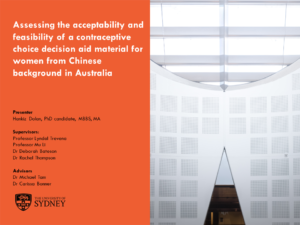 This oral presentation was delivered by Ms Hankiz Dolan at the 10th International Shared Decision Making Conference in Quebec, Canada, 7-10 July 2019. (PDF)
This oral presentation was delivered by Ms Hankiz Dolan at the 10th International Shared Decision Making Conference in Quebec, Canada, 7-10 July 2019. (PDF)
Dolan H. Trevena L, Li M, Bateson D, Thompson R, Tam M, Bonner C. Assessing the acceptability and feasibility of a contraceptive choice decision aid material for women from Chinese background in Australia. 10th International Shared Decision Making Conference. Université Laval, Quebec City, Canada. 2019 July 7-10.
Abstract
Background
Australia is a multicultural country with Chinese being one of the largest, youngest and fastest growing overseas-born groups. There are reports that women from non-English-speaking background and who were not born in Australia are less likely to use modern contraceptive methods than Australian born women due to lack of evidence-based and culturally and linguistically sensitive information. Decision aids are shown to facilitate informed and shared decision-making between patients and healthcare providers. Yet, to date, there is not a Chinese language contraceptive choice decision aid material available in Australia.
Aim
Explore Chinese women and healthcare providers’ views on the feasibility, usefulness and appropriates of a contraceptive choice decision aid material.
Method
We conducted semi-structured in-depth interviews with 22 women from Chinese background and 20 healthcare providers. Chinese women were shown Chinese translated decision aids while healthcare providers were shown the English version. We prompted participants to elaborate on their views and perception on the overall design, information presentation, usefulness and feasibility the decision aid materials.
Results
This study is ongoing, and results will be updated. Both the Chinese women and healthcare providers perceived the decision aid materials of being informative and comprehensive. Chinese women expressed that having the decision aids in Chinese language help them understand and consider available options. While some healthcare providers are concerned about the length of the decision aids, they stated that overall having the material in Chinese language will help discussing available options with their Chinese patients. While healthcare providers are divided on their preference for the use of verbal descriptors or numerical for presenting probability information, Chinese women mostly preferred numerical presentation, which they perceive as more credible and trustworthy.
Conclusion
Contraceptive choice decision aid materials that are available in both Chinese and English can be useful in helping Chinese women making informed decisions about contraceptive methods.
